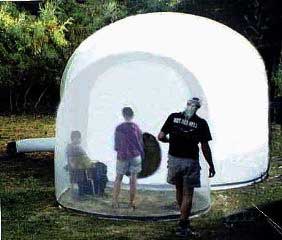LLOYD TURNER
|
|
Even though the nature of concrete is plastic (put fresh concrete into any shape and it will stay that way forever), prior to 1960 architects in this country rarely considered the idea of curved concrete buildings. Due to the use of wooden forms which are linear, we made rectilinear concrete buildings. Forcing wood onto curvilinear shapes for forming concrete was affordable only in countries with low labor costs like Italy and Mexico.
Back then, as a young architect musing over this problem of curved formwork, I came up with an idea. By spraying a few inches of urethane foam to the inside surface of a large inflated shape made of fabric, letting the foam become rigid, then shooting gunite (air emplaced concrete) against this, again from the inside, one could end up with a multi-curved concrete structure, already insulated, with NO form costs. It worked. Licensees of my original patents and others with improvements have since built hundreds of such structures all over the world. There is no question that this use of inflated fabric will continue as one of the best methods of making simple dome-like shapes but it's use to build very refined curvilinear buildings has yet to see the light. Those involved in this method know deep down that its day will come but scratch our heads as to why it hasn't already happened. My wife and I used her sewing machine to make the airform for our house here in Boulder Creek, California. After that it was like making a swimming pool on the inside surface of a huge, inflated, sewn-together cluster of soap bubbles. From the parking area under a large oak tree one approaches what at first glance appears to be a hodge-podge of trees, bushes, vines and small domes. Inside, the unusual exterior changes to the warm atmosphere normally found in old adobe houses: stucco walls, deep arched openings, and tiled floors. Add to this atmosphere dozens of ventilating skylights that saturating everything with natural light and fresh air, and you end up with an ambiance unattainable in normal houses where the light comes entirely through side windows. With no dry-rot or termite concerns this house snuggles into the undulating contours of the site. There is no need for it to rest above the ground as is required with wood construction. When asked to identify the exterior "style", the answer is "California natives. Its fit with nature is such that if you aren't careful you may miss it". |
|
|
Construction Photos
Protruding Niche
|
|






















